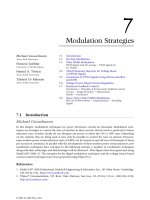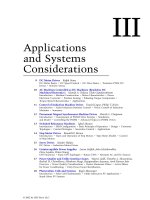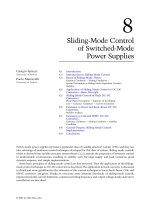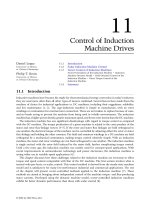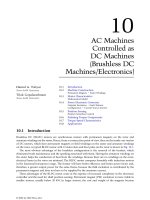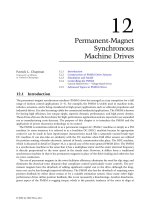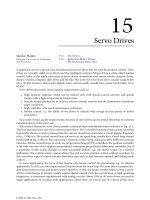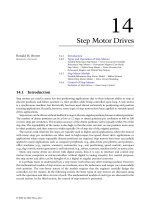Tài liệu Power Electronic Handbook P18 pptx
Bạn đang xem bản rút gọn của tài liệu. Xem và tải ngay bản đầy đủ của tài liệu tại đây (285.33 KB, 10 trang )
© 2002 by CRC Press LLC
18
Photovoltaic Cells
and Systems
18.1 Introduction
18.2 Solar Cell Fundamentals
Conversion of Sunlight to Electricity • Cell Performance
18.3 Utility Interactive PV Applications
The PCU • Simple UI PV System • UI PV System with
Battery Backup
18.4 Stand-Alone PV Systems
Systems with No Storage • Systems with Storage
18.1 Introduction
The ability of certain materials to convert sunlight to electricity was first discovered by Becquerel in 1839,
when he discovered the photogalvanic effect. A number of other significant discoveries ultimately paved the
way for the fabrication of the first solar cell in 1954 by Chapin, Fuller, and Pearson [1]. This cell had a conversion
efficiency of 6%. Within 4 years, solar cells were used on the Vanguard I orbiting satellite. The high cost of
boosting a payload into space readily justified the use of these cells, even though they were quite expensive.
Space applications eventually led to improved production efficiencies, higher conversion efficiencies,
higher reliability, and lower cost for photovoltaic (PV) cells. By the 1980s, PV cells had been introduced
to terrestrial applications where conventional electrical sources were expensive, and by the turn of the
millennium, PV cells have become cost-effective in a wide range of utility interactive and stand-alone
applications. Conversion efficiencies at the turn of the millennium for large-scale PV modules ranged
from just under 10% for thin-film modules to over 30% for gallium arsenide (GaAs) concentrating cells.
This chapter presents a thumbnail sketch of the basic theory of solar cells and then focuses on several
examples of PV applications in utility interactive systems and stand-alone systems. Each type of system
generally requires a power electronics interface unit to enable the PV system to transfer solar electricity
optimally to the desired load or storage system. The intent of this chapter is to present the
what
of PV
systems. For the
why
and
how
of PV systems, the reader is referred to the references at the end of the
chapter that provide detailed examples of specific PV system designs [1–3].
18.2 Solar Cell Fundamentals
Conversion of Sunlight to Electricity
To date, the most popular materials for direct conversion of sunlight to electricity have been crystalline
silicon (Si), amorphous silicon (a-SiH), copper indium diselenide (CIS), cadmium telluride (CdTe), and
gallium arsenide (GaAs). All of these semiconductor materials have band-gap energies between 1 and 2 eV.
The band gap of a semiconductor is the energy required to excite an electron from the valence band to
Roger Messenger
Florida Atlantic University
© 2002 by CRC Press LLC
the conduction band of the semiconductor. Transferring the negative electron to the conduction band
creates a positive hole in the valence band. Both charge carriers are then available for electrical conduction.
Sunlight is a very convenient source of energy for creation of these electron–hole pairs (EHPs), since
most of the energy in the solar spectrum is at levels higher than the band-gap energies of PV materials.
Once the EHP has been produced by an incident photon, the electron and hole must flow in opposite
directions. Separation of electron and hole can be achieved by using a
pn
-junction. A
pn
-junction is
composed of material that is rich in electrons on one side (the
n
-side) and rich in holes on the other
side (the
p
-side). The
pn
-junction produces a built-in electric field, directed from the
n
-side to the
p
-side,
that separates the photon-generated EHPs. The electrons are forced to the
n
-side and the holes are forced
to the
p
-side by the junction electric field as long as the EHP is produced within or close to the
pn
-junction.
If the EHP is generated too far from the junction, the electron and hole will recombine before they can
be separated by the junction electric field.
Figure 18.1 shows photons (
h
ν
) entering a typical PV cell. Some of the photons will create EHPs close
to the surface, some will create EHPs near or within the junction region, and some will penetrate beyond
the junction. Generally, the highest-energy photons produce EHPs close to the surface, whereas the
lowest-energy photons penetrate the deepest. This process of liberating an EHP results in the conversion
of part of the energy of the incident photon to electricity. Any leftover energy is converted to heat.
If the EHP is produced near or within the
pn
-junction, the electron is swept into the
n
-region and the
hole is swept into the
p
-region. The electrons (
−
) then diffuse toward the top of the cell and the holes (
+
)
diffuse toward the bottom of the cell.
As the electrons reach the top surface, where there is a contact to an external circuit, they continue to
flow into the external circuit. As the holes reach the bottom surface, where there is another contact to the
external circuit, they recombine with electrons flowing in from the external circuit. For each electron that
leaves the top, another enters the bottom. This completes the circuit, with electron flow in the external
circuit and the flow of both electrons and holes within the PV cell. The challenge in the design of the PV
cell is to absorb all incident photons close enough to the
pn
-junction so all electrons and holes generated
will be collected. A further challenge in cell design is to minimize conversion of sunlight to heat and
maximize conversion to electricity.
Because of the
pn
-junction, a voltage appears between the bottom and the top of the cell. This
voltage is what forces the current through the external circuit. Depending upon the cell material, the
voltage developed by the cell may range from very small up to about 1 V. Thus, to produce higher voltages,
the cells must be connected in series. When cells are connected together, normally they are incorporated
into PV
modules
, which often combine as many as 40 cells in series to produce voltages in the range of
20 V and currents of several amperes.
When voltages and currents beyond the capability of an individual module are desired, the modules
can be connected into
arrays
that will produce higher voltages and higher currents. Although most cells
FIGURE 18.1
Effect of sunlight incident on the PV cell.
© 2002 by CRC Press LLC
produce only a few watts, and most modules produce 10 to 300 W, most arrays produce a few thousand
watts. A few very large systems have been deployed that produce power in the megawatt range.
An important feature of all modern PV cells is that, over their lifetimes, they can produce up to ten
times as much energy as was used in their fabrication and deployment.
Cell Performance
The ideal solar cell operates as a diode when in the dark, and operates almost as an ideal current source
when operated under short-circuit conditions. The short-circuit current of the cell is close to directly
proportional to the intensity of the sunlight incident on the cell. The current source nature of the cell
means that if cells are connected in series to increase their overall voltage, the cells must be closely
matched so each cell produces identical current under identical illumination conditions. If this is not the
case, the voltage of the series combination will not be optimized. The
I
–
V
relationship for the ideal PV
cell is given by
(18.1)
where
I
l
is the photon-generated current component,
I
o
is the cell reverse saturation current, and
kT
/
q
=
25.7 mV at a temperature of 25
°
C. More specifically, the photocurrent is related to sunlight
intensity by the relationship:
(18.2)
where
G
is the sunlight intensity in W/m
2
and
G
o
=
1000 W/m
2
. Note also from Eq. (18.1) that
I
l
is the
short-circuit current of the PV cell,
I
SC
.
Figure 18.2a shows typical PV cell
I
–
V
characteristics as a function of incident sunlight, and Fig. 18.2b
shows the temperature dependence of the output power of a cell. Note that as the temperature rises, the
open circuit voltage of the cell,
V
OC
, decreases. For Si cells, the rate of decrease is 2.3 mV/
°
C/cell. Thus,
a 36-cell module operating 25
°
C above ambient will lose 36
×
2.3
×
25
=
2070 mV
=
2.07 V. This is nearly
a 10% loss in output voltage, which, when coupled with approximately temperature-independent current,
results in a 10% power loss.
The departure of the
I
–
V
characteristic of a real cell from that of a perfect cell is measured by the
fill
factor
(FF) of the cell. The assumption is that a perfect cell would have a rectangular characteristic, with
FIGURE 18.2
Dependence of PV cell characteristics on sunlight intensity and temperature. (a) Real and ideal PV
cell
I
–
V
vs. sunlight intensity; (b) cell output power vs. cell temperature.
II
l
I
o
e
qV/kT
1–()–=
I
l
I
l
G
o
()
G
G
o
------
=
© 2002 by CRC Press LLC
constant current up to the maximum cell voltage, and then constant voltage. The constant current would
be the short-circuit current and the constant voltage would be the open-circuit voltage. The fill factor is
thus defined as
(18.3)
Since the current produced by a cell depends upon the total power incident upon the cell, if a cell is
shaded even partially, it will not produce the same current as unshaded cells. At a certain point of shading,
the polarity of the cell voltage reverses to enable the cell to carry the current generated by the unshaded
cells in the module. When this happens, the cell dissipates power, and can overheat to the point of cell
degradation. To protect the module against cell degradation, bypass diodes are normally incorporated
into the module design to shunt current away from shaded cells, as shown in Fig. 18.3.
If the voltage of a module drops below the voltage of other modules connected in parallel, it is possible
for the current produced by the higher-voltage modules to flow in the reverse direction of the lower-
voltage module. To prevent reverse flow of current through a module, a blocking diode is sometimes
used in series with the module, as shown in Fig. 18.3.
18.3 Utility Interactive PV Applications
Perhaps the simplest PV application, except for connecting the PV array output directly to the load, is
the utility interactive (UI) system. In a simple UI system, the PV array output is connected to the input
of a DC-to-AC inverter, known as a power conditioning unit (PCU), the output of which is connected
directly to the utility. When battery storage and alternative generation means are incorporated in the UI
system, however, the system is no longer quite as simple. In either case, the PCU must be designed to
meet a wide range of utility concerns. If the heart of the UI PV system is the PV array, then the PCU
may be considered to be the brains of the system.
The PCU
Although the basic UI PV system is quite straightforward, the PCU is a very sophisticated piece of power
electronics equipment. The PCU must meet the stringent design requirements of IEEE Standard 929 [4]
and the stringent performance requirements of UL 1741 [5].
FIGURE 18.3
PV array showing modules with bypass
and blocking diodes.
FF
P
max
I
SC
V
OC
----------------=
© 2002 by CRC Press LLC
Since PV arrays are still relatively costly, it is important for the PCU to extract maximum power from
the array. This is done by incorporating maximum power-tracking circuitry into the PCU. Figure 18.4
shows the
I
–
V
characteristics of an array with the maximum power points indicated for each level of
sunlight. The design challenge for the PCU is to vary the PCU input resistance, defined as the ratio of
input voltage to input current, while sampling the PCU output power. When the PCU output power
reaches a maximum level, the input resistance is fixed at the value that produces this level. Presumably
when output power is a maximum, input power is also at a maximum, provided that PCU conversion
losses remain at a constant percentage of the output power. The effective input resistance of the PCU
can be varied by the use of a buck–boost DC-DC converter.
Nearly all modern PCUs use a pulse code modulation (PCM) scheme for generating an output waveform
of appropriate amplitude and frequency. The PCU is generally designed to perform as a current source
when it is connected to the utility, so the utility voltage can be used as a synchronization signal for PCU
output frequency control. As long as the utility voltage is present at the proper amplitude and frequency,
the PCU supplies power to the grid. However, if the utility voltage or frequency drifts outside prescribed
limits for too long, the PCU is programmed to shut down its output to the utility. Although output is
shut down, the PCU continues to monitor the utility voltage. The PCU reconnects to the utility after the
PCU senses that the utility has remained within amplitude and frequency limits for a predetermined time.
IEEE 1741 prescribes limits for PCU output harmonics and general PCU power quality. It also requires
the PCU to shut down under utility islanding conditions. Islanding occurs when the utility shuts down,
leaving the PV source along with other PV sources connected to the disabled utility line. The trick here
is for every UI PCU to be able to recognize that the presence of power on the utility line from other
PCUs is not the same as power on the line from the utility. Several elegant software algorithms have been
developed to prevent islanding [6].
The output power range of modern PCUs is from a few hundred watts to 100 kW. These units typically
operate with efficiencies in excess of 90% for output powers between 10 and 100% of rated output power.
They are capable of maximum power tracking over a wide range of incident sunlight. Many modern
PCUs that can be used in a grid-independent mode have a sleep mode. In the sleep mode, the PCU sends
out short pulses of AC voltage at regular intervals to sense for connected loads. If current is drawn when
the voltage pulse is sent, the PCU recognizes that a load is connected and remains on until the load is
no longer sensed. The sleep mode sensitivity is usually adjustable. If the PCU includes battery-charging
capability from utility line input, then it normally also incorporates battery protection from overcharge
or overdischarge. Additional features may include provision for code-required fusing and disconnects on
the DC and AC sides of the PCU. A Web search for PV power conditioning units, or PV inverters, will
yield information on a wide range of products. The important consideration in selection of a PCU for
grid-connected applications is the UL 1741 listing.
FIGURE 18.4
Cell
I
–
V
showing maximum power points and associated resistances.
